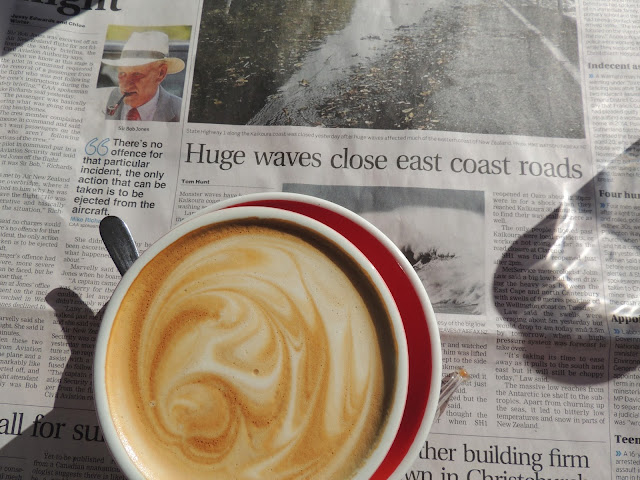For a town of 4,500 people, it's still kickin.' We walked it Thursday, in an almost painfully clear autumn light. Will you join us and indulge me many pictures?To say Hokitika has had a colourful past is a bit of an understatement. At the height of the gold rushes in the 1860’s it boasted 102 hotels. Throw in three opera houses and a whole lot of gold miners and it must have been a rip-roaring town.
That vacation day fizz is in the air because Monday is the Queen's birthday. Her bday is actually April 21, but celebrations are held on various dates across the commonwealth to accommodate each country's public holiday schedule. The secondhand shop of the ASPCA had a particularly appropriate window display.
We started in another secondhand shop, looking for a few necessities, including a wool throw and ceramic plates. We have only plastic in the caravan, and I dislike eating off them. This shop was raising funds for the retired servicemen's building, damaged in an earthquake and razed.
If it could talk,
this suitcase would have some stories to tell
There's a plate, with the Retired Servicemen's Association of Hokitika signature. Classic.
And another!
How about this wool blanket, old and tightly woven and in perfect condition. NZ $10, a bargain. We are having a lucky shopping day.
I can think of at least four people
I could give this to
Sign outside wine bar
We're just a block off the beach, and it's time we took a closer look. Placid in the sun compared to the crashing sea just north at our last campground.
Aoraki/Mt Cook in the far far distance? Sir Edmund Hillary trained for Everest there. It's breathtaking.
Credit where credit is due.
Hokitika town clock
Time for...
There's the Hokitika Museum. We'll go in the coming days.
On to a different town shoreline, this one where the Hokitika River meets the Tasman Sea. Eleanor Catton writes in her book The Luminaries (brilliant as NZ gold) about this river and the Arahura River, whose considerable gravel bars often blocked ships from entering, or worse.
Gold rush history
Perilous arrival at Hokitika
As gold miners left claims farther east to try their luck on the West Coast of NZ, the voyage across the Tasman Sea was not as perilous as the arrival at Hokitika. The problem was trying to get ashore. In 1865-1867 every ten days or so there was a collision, grounding, or shipwreck.Some vessels stuck fast going out, many were grounded coming in, and others were breached due to pilot error or because of tow lines (attached to tugboats) breaking as the ship was being towed over a bar.
Most wrecks were due to the nearly north/south river entrance, which forced ships to enter almost broadside to the sea.
Shipwreck memorial
This is a stunning stretch of beach...if you're not trying to enter the river.
Formerly Bank of New South Wales, built 1905.
Former Bank of NZ building.
Hey, here's yet another secondhand shop, this one run by a Dutchman who came to NZ in the mid 50s. (In here I heard a woman say to her friend: I have no idea what it is, but whatever it is you need it.)
He was a charming guy who said "no Facebook, right?" when I asked if I could photograph him. I'm purchasing that pot lid to cover my new cast iron skillet.
Or whatever.
If this is open,
I'm definitely going to visit
Of course we returned to the bookshop. Art needed a magnifying glass to read his new South Island map book. In my next life, I'd like to design book jackets.
The other queen
Blub




































No comments:
Post a Comment